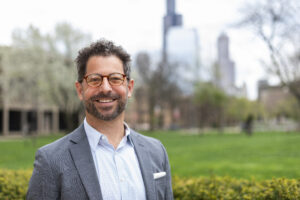Local college and university representatives joined together recently at the Green Town Conference hosted by Columbia College Chicago to discuss making school campuses more sustainable.
The session, called “Greening the Campus: How Educational Institutions Combat Climate Change,” served as a forum for local colleges to compare notes and brainstorm new ideas.
Campuses represented at the session were Columbia College in the South Loop, Heartland Community College in Pontiac, Ill., Grand Valley State University in Allendale, Mich., Ball State University in Muncie, Ind., College of Lake County in Grayslake, Ill., the University of Illinois-Chicago and the University of Chicago.
A few of the schools already have a sustainability plan in motion, while others were there to get advice and direction in starting their own. Most of the schools present have signed the American College and University Presidents’ Climate Commitment (ACUPCC), a pledge to reduce greenhouse gas emissions to zero to achieve climate neutrality.
The event was moderated by Michelle Dyer of Second Nature, a non-profit organization. The goal of Second Nature is to help colleges become more sustainable.
“We are at an evolutionary crossroads,” Dyer said. “Colleges play a major role in sustainability and the future.”
Grand Valley State is one of the Midwest’s first universities to implement a sustainability plan. It was the first to give a presentation at the “Greening the Campus” session. Assistant Vice President of Facilities and Planning James Moyer discussed how his school has achieved its sustainability goals.
Grand Valley State has acquired almost 100 percent LEED certification on its buildings, which means buildings have received high ratings of sustainability and efficiency from the U.S. Green Building Council. The school’s plan is to become carbon neutral by 2015, Moyer said.
Ball State University, which was one of the first 12 schools to sign the ACUPCC, was also highlighted as a school that is forward in its plans to become carbon neutral. Ball State’s presentation was given by professor of architecture Robert Koester. He discussed the school’s geothermal energy plans as well as their programs to involve all faculty and staff in their sustainability efforts.
“We frame sustainability as full campus immersion,” Koester said. “We recognize it as a collaborative problem. It’s not an individual problem.”
After Ball State and Grand Valley State gave their presentations, there was a panel discussion with representatives from Heartland Community College, Columbia College and Ball State. Audience members and other school officials asked questions about what the different sized schools are doing to reduce their emissions to zero and reach climate neutrality.
Columbia College Vice President of Campus Environment Alicia Berg said schools have to be serious about climate neutrality and not set their goals too high too soon.
“We are committed to doing all the studies and planning,” Berg said. “We [can’t] commit to a certain time and date. We want to be real about it.”
Columbia has started several sustainability efforts, including building a new green Media Production Center, creating a sustainability task force and using a “sustainability approach” to all new projects by purchasing materials and furniture that are both green and long lasting, Berg said.
The Green Town conference took place at Columbia as an outgrowth of the college’s campus-wide Critical Encounters lecture series and classes’ topic last year entitled Human/Nature.
Related articles by Zemanta
- University eco policies vital to today’s students (thestar.com)
- Numberscruncher: The College Sustainability Report Card (popdose.com)

![Reblog this post [with Zemanta]](http://img.zemanta.com/reblog_c.png?x-id=8795a203-e3c8-430f-bc80-7037de03ffaa)





Be First to Comment